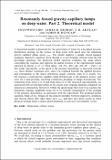| dc.contributor.author | Cho, Yeunwoo | |
| dc.contributor.author | Diorio, James D. | |
| dc.contributor.author | Akylas, Triantaphyllos R. | |
| dc.contributor.author | Duncan, James H. | |
| dc.date.accessioned | 2014-06-04T15:58:31Z | |
| dc.date.available | 2014-06-04T15:58:31Z | |
| dc.date.issued | 2011-03 | |
| dc.date.submitted | 2010-10 | |
| dc.identifier.issn | 0022-1120 | |
| dc.identifier.issn | 1469-7645 | |
| dc.identifier.uri | http://hdl.handle.net/1721.1/87625 | |
| dc.description.abstract | A theoretical model is presented for the generation of waves by a localized pressure distribution moving on the surface of deep water with speed near the minimum gravity–capillary phase speed, c[subscript min]. The model employs a simple forced–damped nonlinear dispersive equation. Even though it is not formally derived from the full governing equations, the proposed model equation combines the main effects controlling the response and captures the salient features of the experimental results reported in Diorio et al. (J. Fluid Mech., vol. 672, 2011, pp. 268–287 – Part 1 of this work). Specifically, as the speed of the pressure disturbance is increased towards c[subscript min], three distinct responses arise: state I is confined beneath the applied pressure and corresponds to the linear subcritical steady solution; state II is steady, too, but features a steep gravity–capillary lump downstream of the pressure source; and state III is time-periodic, involving continuous shedding of lumps downstream. The transitions from states I to II and from states II to III, observed experimentally, are associated with certain limit points in the steady-state response diagram computed via numerical continuation. Moreover, within the speed range that state II is reached, the maximum response amplitude turns out to be virtually independent of the strength of the pressure disturbance, in agreement with the experiment. The proposed model equation, while ad hoc, brings out the delicate interplay between dispersive, nonlinear and viscous effects that takes place near c[subscript min], and may also prove useful in other physical settings where a phase-speed minimum at non-zero wavenumber occurs. | en_US |
| dc.description.sponsorship | ARCS Foundation | en_US |
| dc.description.sponsorship | National Science Foundation (U.S.) (NSF grant DMS-0604416) | en_US |
| dc.description.sponsorship | National Science Foundation (U.S.) (NSF grant DMS-098122) | en_US |
| dc.description.sponsorship | National Science Foundation (U.S.) (NSF grant OCE-751853) | en_US |
| dc.description.sponsorship | United States. Air Force Office of Scientific Research (AFSOR (grant FA9550-07-0005)) | en_US |
| dc.language.iso | en_US | |
| dc.publisher | Cambridge University Press | en_US |
| dc.relation.isversionof | http://dx.doi.org/10.1017/s0022112010006002 | en_US |
| dc.rights | Article is made available in accordance with the publisher's policy and may be subject to US copyright law. Please refer to the publisher's site for terms of use. | en_US |
| dc.source | Prof. Akylas via Angie Locknar | en_US |
| dc.title | Resonantly forced gravity–capillary lumps on deep water. Part 2. Theoretical model | en_US |
| dc.type | Article | en_US |
| dc.identifier.citation | Cho, Yeunwoo, James D. Diorio, T. R. Akylas, and James H. Duncan. "Resonantly forced gravity–capillary lumps on deep water. Part 2. Theoretical model." Journal of Fluid Mechanics 672 (April 2011), pp 288-306. ©Cambridge University Press 2011. | en_US |
| dc.contributor.department | Massachusetts Institute of Technology. Department of Mechanical Engineering | en_US |
| dc.contributor.approver | Akylas, Triantaphyllos R. | en_US |
| dc.contributor.mitauthor | Akylas, Triantaphyllos R. | en_US |
| dc.contributor.mitauthor | Cho, Yeunwoo | en_US |
| dc.relation.journal | Journal of Fluid Mechanics | en_US |
| dc.eprint.version | Final published version | en_US |
| dc.type.uri | http://purl.org/eprint/type/JournalArticle | en_US |
| eprint.status | http://purl.org/eprint/status/PeerReviewed | en_US |
| dspace.orderedauthors | CHO, YEUNWOO; DIORIO, JAMES D.; AKYLAS, T. R.; DUNCAN, JAMES H. | en_US |
| dc.identifier.orcid | https://orcid.org/0000-0002-5246-4574 | |
| mit.license | PUBLISHER_POLICY | en_US |
| mit.metadata.status | Complete | |
